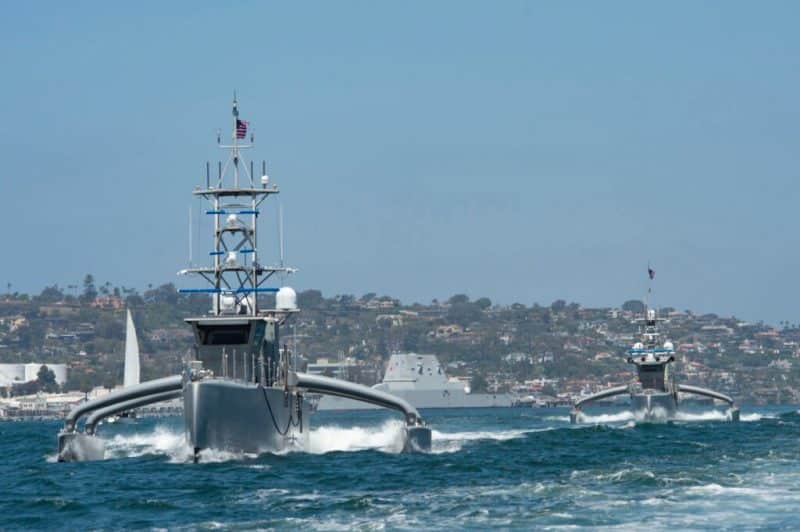Par Noam Akhoun
At a time when drones are reshuffling the cards of war, the naval field is far from being spared by this development. Unlike the air and / or land support drones that we could see at work during the conflict between Azerbaijan and Armenia, or in Syria, ships without pilots, or naval drones, have not yet been in combat but it may happen faster than we think. With directed energy weapons, hypersonic weapons, artificial intelligence and cyber capabilities, unmanned ships (unmanned vessels ou unmanned surface vessels - usv) are one of the new capabilities, at the heart of the concerns of the American military services. These ships offer complete versatility, being able to respond as much to surveillance functions as to attack functions.
These vessels will be operated remotely in a semi-autonomous manner, and in a completely autonomous manner in the long term. One of the direct advantages of such vessels is their cost. Once fully autonomous, their design no longer requires the incorporation of spaces and support equipment for the personnel on board, which reduces the cost of these ships but also that of the missions during which this type of ship will be mobilized. In addition, the absence of human operators will make these ships particularly suitable for long-term missions, as long as reliability is met. In short, they will make it possible to respond to boring, dangerous and physically demanding missions. As Marshal Foch remarked about the Navy: “we landowners have weapons to equip our men, you sailors have men to arm your boats”. For the navy, the current challenge does indeed seem to remove the last men still on board, at least on part of its vessels.
The American advance in this area
At the 2021 Sea Air Space Symposium, Captain Pete Small, US Navy Program Director for Unmanned Ships discussed the development of these programs. He said that accommodation for a small personal detachment would be provided, but only for operations that cannot yet be automated, such as refueling. The concepts of operations and issues of human presence are therefore still being considered. As envisioned, the large unmanned ships are designed to carry a vertical launch system that will provide additional missile capability to the Navy's fleet of guided missile cruisers, destroyers and emerging frigates of the Navy. Constellation class (FFG-62). In short, it is an “additional charger” said Captain Small.
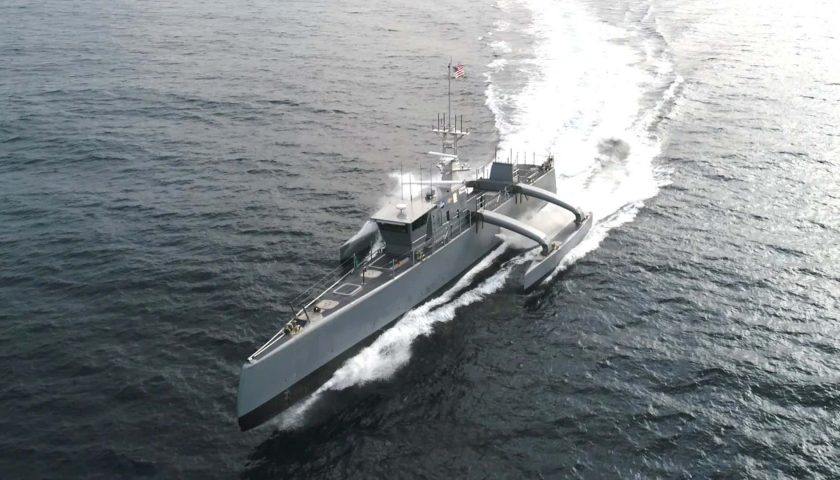
After having tested two mid-size unmanned vessels, sea hunter et sea hawk, the US Navy embarked on the development of large ships. These are the prototypes Nomad et Tidy. They have made test trips from the Gulf Coast to their current home in California. Ships only switched to manual mode when passing through the Panama Canal. The remainder of the trip was therefore controlled from California.[1]In this same conference, certain elements were put forward on the current operation of unmanned vessels. It would seem that a small crew on board is always necessary to enter and leave the port, and during certain navigation operations. But, once on the high seas, the transition to autonomous mode is achieved, and remote mission planning and command and control operations are continued.[2] In addition, drone control was also carried out from a class central command ship. Zumwalt.[3]
The US Navy is therefore innovative and avant-garde in this area. In the final weeks of the Trump administration, the Pentagon released an ambitious, unfunded plan, for a vastly enlarged navy by 2045, which would include more than 200 unmanned ships and submarines. While many of these devices would likely still be controlled remotely by teams of operators, the Navy is increasingly considering how to use advances in machine learning and artificial intelligence to provide autonomous control. . [4] The stake for the American army is obviously to compensate for its delay vis-à-vis the Chinese navy, which is now lining up more ships.[5]
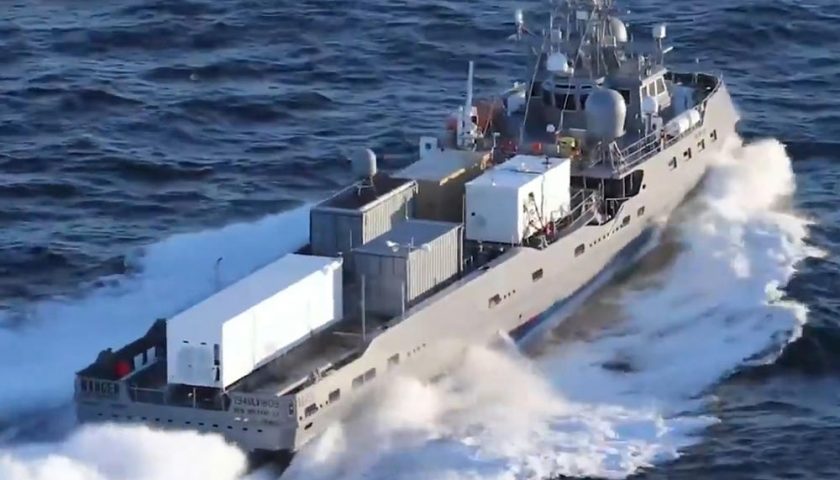
In 2020, the Navy signed contracts worth $ 42 million for studies of the large unmanned surface vessels, Austal USA, Huntington Ingalls Industries, Fincantieri Marinette, Bollinger Shipyards, Lockheed Martin and Gibbs & Cox each raising around $ 7 million. If the American advance is manifested by the empowerment of large ships, the projects do not neglect smaller ships. The example of the project of the company Metal Shark is in this respect significant. Small in size (a little over ten meters), the long range unmanned surface vessel system will be equipped with Hero 120 vagrant ammunition.[6]
Turkish industry successes
In the field of drones, Turkey has shown itself to be particularly innovative. Everything suggests that the Turkish naval industry is also in the process of “dronization”. In February 2021, the Ares shipyard and Meteksan Defense Industry launched and began sea trials of the first unmanned, armed, and fully produced surface vehicle in Turkey.[7] The Turkish “ULAQ” is an armed surface drone, and can be deployed from a larger vessel. It has a range of 400 km and a speed of 35 knots. On the other hand, its reduced dimensions limit its use to coastal missions, the ship not being cut out to face heavy seas. It carries four Cirit missiles and two L-UMTAS laser-guided missiles supplied by Roketsan. After successful firing tests in June 2021, this ship could well be one of the first fully operational naval combat drones.[8]
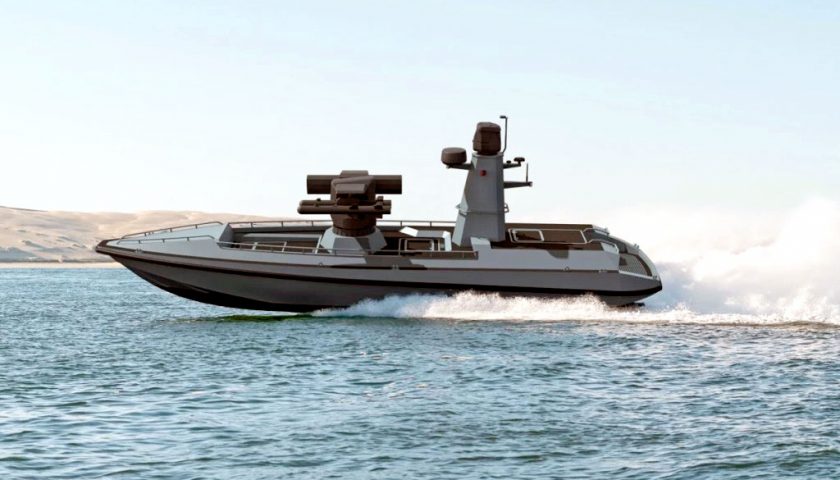
Understandably, the country's industrial and military elites are therefore seeking to repeat the exploits of their combat drones. The manufacturer considers it possible to produce around fifty ULAQs per year.[9] Such production capacity, and particularly low costs, make a high attrition rate of the fleet acceptable. The famous Bayraktar TB-2s have therefore inspired the entire Turkish drone industry. The Turkish navy could easily deploy numerous ULAQs to saturate the defenses of opposing ships, or to escort larger Turkish ships, like the famous fasting chief. In addition, Turkish manufacturers Arelsan and Sefine have joined forces to produce two surface drones NB57 and RD09. Both ships will be able to navigate up to 40 knots. They will have an operational range of 600 nautical miles and will be able to hold the sea for four days without resupply. The companies did not disclose information about the size and tonnage of these devices.
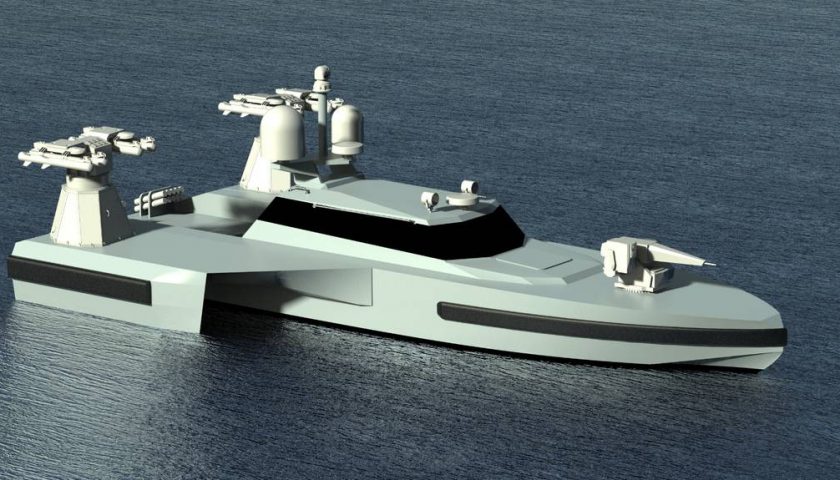
These vehicles may be transported by cargo plane, warship or land to the mission area. Furthermore, thanks to its convertibility to a trimaran with an expandable platform, the payload capacity of the RD09 can be increased to carry more weapons and systems when needed. It will also be able to perform electronic warfare, anti-submarine warfare and mine countermeasures missions. The new vessels will be equipped, according to the manufacturer, with robust automation technologies that will ensure adaptive navigation under the detection of on-board sensors and will be able to navigate autonomously according to the rules of maritime traffic. In addition to Aselsan's STAMP automatic cannon fitted to both ships, the RD09 will be equipped with two tactical missile launchers developed by Roketsan, while the NB07 will be equipped with light 2 × 2 torpedoes.[10]The two projects, Ares and Arelsan-Sefine, are in competition benefiting the Turkish defense industrial and technological base.
A proliferation of ambitious projects, but does France risk missing the boat?
If the Turkish and American industrial dynamics seem to be the most advanced on this subject, certain projects deserve to be highlighted. Launched in 2020, the drone swarm project by the South Korean company Hanwha is particularly avant-garde. Once development is complete, a group of artificial intelligence (AI) -based unmanned vessels will be deployed to South Korea's coastal areas to patrol and counter invading forces. These ships connected by wireless networks will also be able to search for mines.[11] Israel's experience in this area is also notable and the Seagull, an autonomous light ship since 2016, has also been fitted with Leonardo torpedoes, further strengthening its capabilities for action.[12]
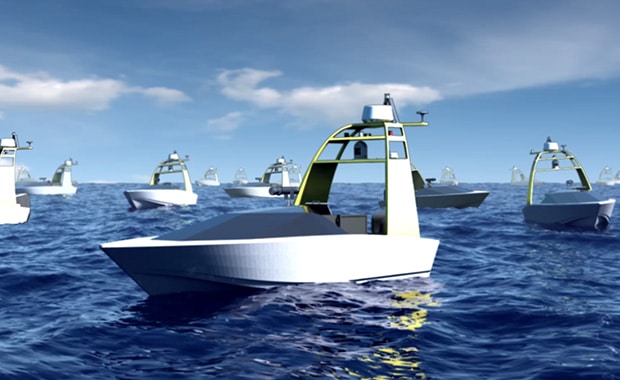
For European industries, the projects seem much fewer and important. The French have developed two naval drones, namely the IXblue Drix, for hydrographic and oceanic research, and the USV inspector 125 of the company ECA.[13] The latter project is suitable for a series of defense and security operations such as anti-submarine warfare, oceanographic studies, intelligence, surveillance and reconnaissance, or mine action. The versatility of such a vessel offers a plethora of possibilities, but let us keep in mind that this platform is derived from the so-called V2 NG lifeboats in service at the Société Nationale de Sauvetage en Mer (SNSM) for ten years.[14] In other words, this ship is not oriented combat and support of the forces. the recent Naval Group project on an oceanic underwater drone is innovative and can differentiate the French industrialist and support the increase in competence of the French navy. It should also be remembered that, in the field of mine warfare, Thales and Naval Group are both engaged in programs making extensive use of naval drones, respectively for the French Navy in cooperation with Great Britain, and for the Belgian navies and Dutch in cooperation with the ECA group and its Belgian subsidiary ECA Robotics,
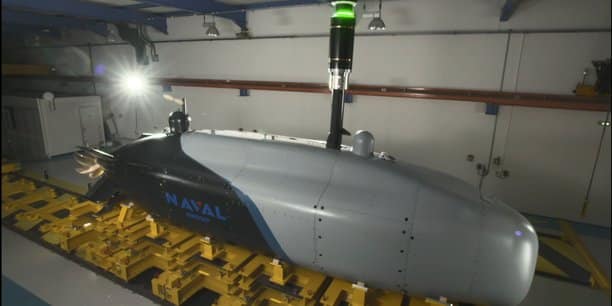
On the other hand, the arming of the USV is a trend which seems to be confirmed, as the Turkish, American and Israeli projects suggest. Especially since if we keep in mind the return to high intensity, it is essential to increase the firepower of the French Navy. In a recent article published in the journal Conflits, Alexis Feertchak thus engaged in an accounting exercise of all the vertical launch systems of the National Navy, according to which 'all the French frigates currently total 320 silos, there or China lines more than 3000 ports and Japan, about 1800.[15] Consequently, the American vision which consists in using the USV as remote detectors, but also as effectors carrying additional weapon systems can make sense in the French context, and more broadly in Europe. It is probably necessary to humbly look at the recent, and more generally European, delay in a certain number of technologies, like the MALE combat drones, and not to repeat the same mistakes made in this area. In all likelihood, indeed, unmanned ships will play a crucial role in future conflicts and, once again, tomorrow's independence is being played out now.
[1] https://news.usni.org/2021/07/27/ghost-fleet-hulls-moving-toward-completely-unmanned-operations
[2] https://news.usni.org/2021/08/03/navy-large-usv-will-require-small-crews-for-the-next-several-years
[3]https://news.usni.org/2021/03/22/zumwalt-destroyer-will-control-unmanned-ships-aircraft-in-upcoming-fleet-battle-problem
[4] https://thediplomat.com/2021/07/us-navy-unveils-strategy-for-autonomous-vehicles/
[5] https://thediplomat.com/2021/07/us-navy-unveils-strategy-for-autonomous-vehicles/
[6] https://navalpost.com/usmc-metal-shark-boats-hero-120/
[7] https://www.navaltoday.com/2021/02/17/ares-meteksan-launch-turkeys-first-indigenous-ausv/
[8]http://www.opex360.com/2021/06/01/le-bateau-turc-sans-equipage-ulaq-a-effectue-avec-succes-son-premier-tir-de-missile/
[9]https://www.hurriyetdailynews.com/turkeys-first-armed-unmanned-surface-vessel-ready-to-launch-missile-164573
[10]https://www.navalnews.com/naval-news/2021/07/turkish-companies-team-up-for-new-armed-usv-projects/
[11] https://navalpost.com/hanwha-systems-joins-south-koreas-cluster-usv-control-project/
[12]https://www.navaltoday.com/2018/12/06/elbit-leonardo-join-forces-to-equip-seagull-usv-with-mini-torpedoes/
[13] https://www.naval-technology.com/projects/inspector-125/
[14] https://www.ecagroup.com/en/solutions/unmanned-surface-vehicle-inspector-125
[15] https://www.revueconflits.com/sabords-feertchak/

